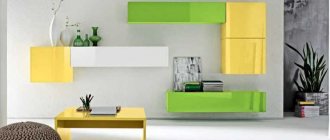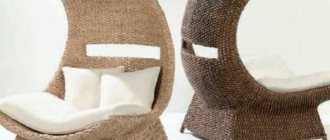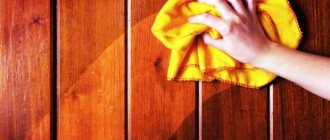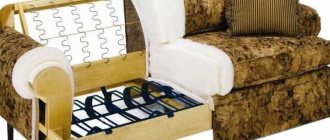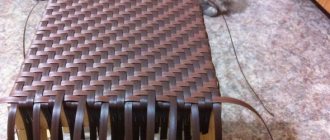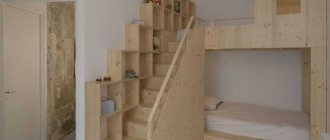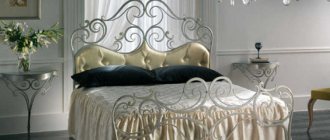Rattan wood has a three-layer structure: the top layer is made of durable bark, the middle layer is soft and porous, and inside the palm is a hard core.
Sunlight rarely reaches the depths of the tropical forests, where the vines grow; they tend to rise, twining around the trunks of the trees closest to them. That is why local residents nicknamed rattan “crawling vine.” During strong winds and storms, the vines often fall down, but do not break, but curl up in tight rings. When the storm subsides, they cling with thorns to nearby trees and rise up again.
Palm rattan
The rattan palm liana is a record holder plant for length (reaches 250-300 m) and is a smooth trunk without knots (up to 7 cm wide). The record holder among rattans grows in mountainous India and grows up to 350 m.
The palm liana usually grows in dense tropical forests, where there is always not enough light, so it makes its way to the sun, clinging and twisting around the trunks of nearby tall trees with its hooks, and so rises to the very top, which is why it is called the “climbing liana.” "
Interesting! During periods of strong wind and storms, rattans fall down and curl into prickly rings, and then begin to rise again, using nearby trees as support.
Its distinctive feature is that it has exactly the same diameter along its entire length, while it bends easily and can take any shape when processed with steam . The most common type is tree rattan.
There are also inflexible species of this plant that grow upright at 5-8 m in height (erect rattan).
Calamus palm can withstand any temperature changes and pressure surges and has good elasticity.
Photo:
- spiny stems of rattan palm:
- rattan plantation (Philippines):
What is rattan
Rattan is a plant material that is actually a common palm tree. In addition to the most famous name for this type of wood, you can also find synonymous names - “rattan” and “calamus”. They all refer to the peeled and dried stems of a tropical palm tree that grows mostly in Southeast Asia (Malaysia) and Indonesia. By the way, Indonesian raw materials are valued higher than Malaysian ones, as they are stronger.
The length of the described stems can reach 300 meters, so the aborigines gave it the nickname “devil’s rope”.
Structurally, rattan stems consist of three layers:
- bark;
- porous layer;
- hard core.
The thickness and porosity of the stem affects the strength of the manufactured furniture. This principle of different stems forms the basis for dividing it into classes in the production of furniture.
There are three of them: A, B and C, with class C considered the lowest. The cost of such furniture is significantly lower than that of the other two. The price of the same piece of furniture of class A and class C usually differs by 2-2.5 times.
Artificial rattan - what is it made from?
Polyrattan is a plastic synthetic tape of different widths and lengths, for the production of which the method of extrusion from polyethylene and rubber with various additives is used. The first substitute for real rattan was made in Indonesia in the 50s of the last century and was called “khularo”.
Artificial rattan is produced in 3 types: with imitation of tree bark (natural), rod and crescent. It is usually supplied in reels on which fiber of various widths and textures is wound.
Polyrattan rods are hard and plastic polymer fibers (standard thickness from 2 to 4 mm).
The variety with imitation of natural bark consists of semicircular polyethylene fibers with a thickness of 4-12 mm.
Textured strips have a flat-rectangular fiber shape with a width of 6-12 mm.
Advantages of artificial rattan:
- greater resistance to moisture and sunlight;
- does not require special care or storage space;
- Available in a variety of textures and colors;
- recyclable.
What is synthetic rattan and how is it made?
In addition to furniture and other design items made from natural rattan, products made from its artificial counterpart are also interesting. The latter is also called techno- or poly-rattan - it is an especially durable, high-quality and, importantly, environmentally friendly artificial material, the invention of which made it possible to furnish not only a house and a cottage, but also garden verandas, gazebos and landscapes with wear-resistant and beautiful furniture.
The innovative material was invented by German chemists back in the 90s of the last century. Since then, such furniture has become popular both among buyers all over the world and among designers.
Artificial rattan is produced by extrusion, that is, pressing melted synthetic raw materials through holes of a certain size. The resulting technorattan resembles a plastic tape or cord and comes in the following modifications:
- tape with imitation tree bark;
- round rod;
- flat texture stripe.
The length of such a blank can be arbitrary, which allows you to have no joints when making furniture. This feature of artificial rattan makes furniture made from it the most comfortable. Reinforcement with silk or nylon threads gives additional strength to technorattan. This material can be of various colors, which allows you to create furniture for any interior of an apartment or country house, which attracts designers from all over the world.
Rattan color, is there white rattan?
When preparing rattan for the production of furniture from it, it is painted in 4 main colors: honey, olive, cognac and coffee . Occasionally, colored rattan is made (black, red, white, etc.).
The palm trunk itself is almost white before processing . Before painting, the trunks are classified for evenness, structure, and the presence of flaws. The highest quality trunks are usually painted a honey color .
Technology for dyeing rattan in golden honey color:
- the trunks are varnished twice with a certain period of time;
- processing is carried out using liquid glass to impart strength and increase moisture resistance, the glass impregnates all cracks and closes them;
- treatment with hydrogen peroxide to give a pure white color;
- The final stage is varnishing, which gives the material a honey tint.
Lower quality trunks are painted using a simpler method: after a single varnish coating, they are painted with the desired paint. Only natural dyes are used that are harmless to human health.
Thus, white rattan is a material that is not treated with paint, but furniture of this color looks very stylish and beautiful.
Furniture made from natural and artificial rattan: how it is produced, its properties
Previously, wickerwork was made only in countries where the vine itself grows - in Indonesia, the Philippines, etc. Now they have learned to make furniture in European countries and in Russia, and they export exclusively natural rattan itself.
Natural rattan furniture
Natural materials are used to make both large products (cupboards, sofas with soft pillows, beds, dining and coffee tables) and smaller ones (rocking chairs or other models, chairs, lamps, stands for decorative elements, etc.). Modern designers, when developing new furniture models, use a combination of it with other materials: strips of fabric, wood, leather, metal and plastic, glass.
The furniture frame is usually made from strong bent vine stems, and rattan fabric is attached to it using special wooden pins and strong strips of leather.
To make fabric, the rattan vine is split into individual fibers, after which they are intertwined in various ways. The fabric can be of two varieties (thick or openwork), the weave in it is made either from bulk fibers or from flat ones. The strength of such furniture is determined by the density of the canvas itself and the number of joints (of course, the fewer joints, the stronger).
Photos of natural rattan furniture:
Attention! Although rattan furniture can withstand heavy loads, standing on it or jumping on it, for example, is completely undesirable and can cause damage.
Advantages of rattan furniture:
- it is made from natural material, and therefore does not harm the environment and is very good for health;
- each model is exclusive, because it is made by hand;
- has strength and good moisture resistance, lasts longer than conventional wooden furniture;
- such furniture does not require additional substances when caring - it is enough to wipe it from dust;
- It is lightweight, making it easy to move and transport;
- the furniture has a special smell and texture that creates a positive mood and even provides a micro-massage;
- furniture does not need to be assembled, it is bought ready-made;
- it tolerates changes in temperature and humidity well, and therefore can be located both inside a building and outside without any damage;
- The service life of rattan furniture is 20-25 years.
- the price of a rattan product depends on many factors - which part of the vine is used, the method of processing the trunk, various types of weaving and fastening.
Rattan: types and applications
Natural rattan is obtained from the stems of the calamus or rattan palm. This is a tropical plant that creeps up towards the sun, twining around tree trunks. The stems of the palm tree, with a height of 80 to 300 meters, are very flexible and strong in structure, while being smooth, without any knots.
In Southeast Asian countries, they are used to build houses, make clothing, accessories, and very durable sticks that were used as contact weapons.
There are many types of rattan palms, which have different characteristics, allowing them to be used for different purposes:
- Himalayan rattan is the shortest type of vine, only 25 meters; lampshades, vases and Indian musical instruments are made from this species.
- The malacca palm , which is weakly flexible and heavy, is used to make umbrella handles and elegant walking canes.
- Rattan of the Tohiti genus is used in furniture production - a light, plastic light stem.
The stems of the rattan palm of the dragon family were used for flogging in the second half of the 19th century in Great Britain, which actively traded with the colonies, and were an extremely popular tool for punishing careless students. Dragon rattan canes had little flexibility and were quite heavy compared to other types of calamus.
- Cerotolobus is a thin, weak, soft vine growing in Malaysia, Borneo, Thailand and the islands of Java and Sumatra. It is used to weave lampshades, carpets and baskets.
- The manau palm grows in Sri Lanka, India and China, as well as Malaysia. This is the most popular type of palm tree for making garden furniture. Its wide and weakly bending stem is boiled for a long time in palm oil to make it more pliable.
- “Devil's Rope” - Daemonorops is suitable for both outdoor, home and restaurant furniture. From the fruits of this palm tree, a special ruby resin is also extracted for varnishing marble and wooden products - “dragon’s blood”.
Artificial rattan furniture
Just like when working with natural materials, making furniture from poly rattan is a manual process. But the technology is different: first, a frame is made (usually from a steel or aluminum profile with special anti-corrosion treatment), the joints are welded and ground. It is then painted and baked in an oven, making the coating more durable. Such furniture can withstand a load of 250-300 kg, although it itself weighs little.
When the frame is ready, the process of braiding with the artificial fabric itself occurs.
There are differences when using polyrattan fabric:
- fiber for weaving is supplied in reels and is longer, therefore the number of joints in products is always less than in natural furniture;
- artificial fiber is very similar to natural fiber in texture and color, but also has many other more modern and bright colors;
For your information! Particularly popular now are the volumetric armchairs “Papasan” and “Mamasan”, which can accommodate several people or a father/mother with a child (size 100-120 cm). These chairs are usually equipped with a huge soft pillow.
Rattan furniture from the Papasan series
At first it was used in places where natural rattan was not suitable (for example, for screens on radiators). Nowadays, it is often used to make furniture for the dacha, since it can simply be washed with water and not hidden indoors for the winter.
However, artificial material has some disadvantages:
- it is less durable (which is why a metal frame is used in products);
- does not have natural energy.
Artificial rattan. Country furniture set.
Some home craftsmen have already learned to make small items from artificial rattan with their own hands. Most often they make stools, small tables, and small items to decorate the home interior.
Questions and answers
What is rattan?
The rattan palm has a perfectly smooth trunk, without knots and side branches, as well as an equal stem diameter: from 5 to 70 mm along the entire length. Its wood consists of a very strong bark, a soft porous middle layer and a fairly hard core. This material is elastic, strong, is not afraid of water and is not inferior in strength to other, harder types of wood. It is believed that rattan is better than willow or wicker. What is artificial rattan? – This is a synthetic fiber with an ultraviolet coating, which is as close in appearance as natural rattan. This is a very durable and, importantly, environmentally friendly material. Furniture made from artificial rattan is very durable.
How long does furniture last?
Service life is up to 25 years. Based on our practice, with proper care, this figure is quite realistic.
How to care for natural rattan furniture?
Caring for such furniture is very simple - it is not recommended to let rattan furniture get wet for a long time. You can leave it in the rain, but then you will need to dry it. To do this, simply move the furniture to a dry, ventilated room where it will dry naturally. It is necessary to avoid prolonged exposure to direct sunlight, as the varnish coating may crack or fade. Furniture should not be placed close to open fire sources or heating devices. It is not recommended to stand on it with your feet, if this is not provided for by the design, or to swing or jump. You should also avoid contact with furniture with cleaning products such as solvents, acetone, as well as fuels, lubricants and paints. If you find scratches on the furniture, you can easily get rid of them by wiping the damaged area with a cloth moistened with polyurethane varnish.
Are pillows washable?
Many pillows will not fit in the washing machine, so we recommend hand cleaning or dry cleaning.
Is it possible to store furniture on the balcony or street?
Furniture made from natural rattan can be stored in an unheated room.
Pillow filler?
Possible fillers: pieces of fabric, half-finder (analogue of padding polyester)
The weight that the furniture can support?
armchairs and rocking chairs made of natural and artificial rattan can withstand up to 120 kg. Sets: chairs up to 110 kg. (triple rattan weaving up to 120), sofa up to 160 kg.
Guarantee period?
2 weeks to identify visible defects, and 6 months. For hidden defects (note: if a leg is broken and we see that there is a sawn-off knot at the break site*).
Is the chair (furniture) comfortable?
Rattan furniture is very comfortable and cozy and fits perfectly into almost any interior.
If they bring us furniture and we don’t like it, can we refuse it?
Yes, you can cancel the order, but you must pay for delivery.
Is there an assembly service?
We do not provide this service.
Cost of delivery to the region? Delivery period? And how should I pay the whole amount or can I pay in part?
Prepayment of furniture 100%, payment of transport costs upon receipt. You need to check the cost and delivery time with your chosen shopping center.
How does artificial rattan differ from natural rattan?
Artificial rattan is made from polymer material. This type of raw material is distinguished by its plasticity and variety of parameters; it can be used to weave arbitrarily long and complex elements. However, the polymer is relatively soft, so the furniture is reinforced with a frame made of aluminum or molded plastic. A significant advantage of artificial rattan is its resistance to weathering and high humidity. This furniture is very easy to care for and can be washed with a hose. At the same time, the artificial material is almost indistinguishable from the real thing in appearance.
What load can rattan furniture withstand?
Even the thinnest and most elegant furniture can withstand a weight of up to 150 kg. The indigenous people of Southeast Asia used rattan to build bridges! The durability of the furniture ensures a minimum number of joints in the structure. The seams are secured with pins made of plastic, wood or metal, or tied with strips of leather. The highest quality models have only one joint. When purchasing furniture, it is important to ensure its integrity and careful processing.
Is it possible to leave rattan outdoors?
Yes, rattan furniture is quite suitable for this. Rattan benches, chairs, and sofas have been decorating the gardens since the 12th century. They can be kept on porches, poolsides, and backyards. Artificial rattan is most resistant to high humidity: it is not afraid of even the heaviest downpours.
Are wicker furniture affected by high or low temperatures?
In general, natural rattan is not afraid of either heat or frost. It does not melt, does not become covered with frost, and does not crack. Furniture made from artificial material is even more resistant to temperature changes. To date, there is no information about rattan furniture damaged by heat or cold.
Rattan Outdoor Furniture
Rattan outdoor furniture has gained great popularity in recent years. It can be used in country houses or in the country, and can also be installed in open areas of cafes or restaurants.
Garden furniture made of natural rattan (sofas, chairs, comfortable armchairs, various tables and small items) has elegance and practicality. Such furniture is light and elegant; it will easily fit into an interior that imitates antiquity, as well as a modern one (for example, Japanese style). A set of table and chairs is ideal for creating a cozy and friendly atmosphere for an outdoor dinner with the whole family. Examples of outdoor furniture:
Such furniture does not fade or deform over time. To give it a beautiful appearance, it should be additionally coated with varnish every few years, which will also help improve its wear resistance.
Furniture made from artificial material even surpasses natural material in some characteristics, and therefore is often used for country houses. The main advantage of such country furniture is that it is less susceptible to atmospheric influences: it does not fade in the sun, is not afraid of water and frost (it does not need to be put away indoors for the winter).
Therefore, furniture made of artificial material is considered ideal for outdoor use at any time of the year.
How to choose technorattan furniture for your garden
It is believed that it is not difficult to choose furniture made from artificial fiber; it is enough to visually inspect the model to understand whether it is suitable or not. Polymer pieces of furniture are not divided into classes and the name of the manufacturer is unlikely to say anything significant about their quality.
The popularity of synthetic rattan has become an indirect reason for the appearance on the market of a very large number of low-quality products.
In order for technorattan furniture to serve for a long time, it is worth taking into account the following:
- What is the frame made of ? The most popular solutions for strengthening the structure are bases made of steel, aluminum or cast plastic frames. Aluminum bases should not be thin as they are not durable. Steel frames are not advisable if the furniture is intended to be used in the garden, not under cover, as they will corrode over time.
- The degree of fiber tension in woven products . Simple pressure can determine the degree of resistance; the weave itself should not bend under pressure.
- Weave fiber density . The closer together the rattan fibers are, the stronger the product. Sometimes it is better to choose furniture with additional reinforcement located on the inside in the form of a metal mesh or other fastening elements.
Furniture made of synthetic fiber should have only one joint, only then can it be considered high quality. There should be no burrs or cracks on the surface of the products.
Natural rattan and artificial: which is better?
General benefits for rattan furniture (both natural and artificial):
- Lightness and functionality - without physical effort you can move it to a more suitable place, change the interior, come up with and implement new design solutions for your home.
- The aesthetic appearance of wicker furniture is that it is flexible, has a wide variety of shapes and colors (from shades of natural wood to bright modern colors), and goes well with glass (tabletop), metal (to increase strength), fabric and leather.
The difference between products made from natural and artificial materials:
- Artificial fiber is a cheaper material, its price is lower than natural fiber.
- Products made from artificial material are more practical and are not affected by atmospheric conditions (heat and rain), they do not need to be hidden under a canopy.
- The service life of an artificial product is less than a natural one - manufacturers usually provide a 10-year warranty.
- Furniture made from natural rattan does not age over time, but acquires an antique appearance, and will serve more than one generation of owners.
- There are differences in caring for rattan furniture: it is best to wipe natural furniture with a dry cloth, while artificial furniture can even be washed with water from a hose (for example, in the country).
Palette of options
You should not consider wicker furniture as some kind of alternative to “classic” furniture. She has her own niche, outside of which rattan crafts look, at least, tasteless.
I recommend: How to make a bench with your own hands
At the same time, often a wicker element added to a seemingly completely incompatible style gives the interior a unique “zest”. Therefore, it will be useful to know the properties and capabilities of such products.
The more types of furnishings we are familiar with, the richer our aesthetic sense, the wider the design “palette”.
Leave your tips and comments below. Subscribe to our newsletter. Good luck to you and good luck to your family!
Reviews of rattan furniture
Reviews from happy owners of rattan furniture are mostly positive, although there are also some concerns (especially for overweight people who have a lot of weight) that the furniture can withstand their weight for a long time.
Also, some owners complain that over time, natural rattan furniture begins to creak, which also causes some problems.
Like any material, rattan (natural and artificial) is produced in different qualities and therefore such products differ in their properties in operation. Of course, if luxury rattan material was used in production, then its service life is longer, but the price of the furniture is more expensive.
How the stems of a creeping vine turn into garden furniture
In order for the vine stem to turn into a country chair, it is first cleared of leaves and buds, the bark is removed, then it is treated with steam or boiled for 1-2 hours in water with the addition of palm oil, and only after drying a very plastic flexible material suitable for weaving is obtained .
Rattan bark also comes into play; braiding is often made from it.
The material is produced where it grows: in the jungle or on special plantations, and furniture is also woven there. Finished products are coated with varnish or wax.
Only manual labor is used in the production of natural rattan furniture. That is why rattan furniture is quite expensive; the price of products is also affected by the costs of suppliers for delivery of goods.




